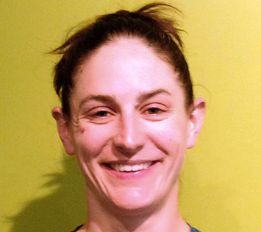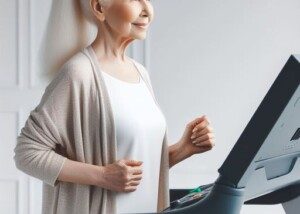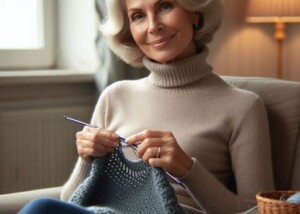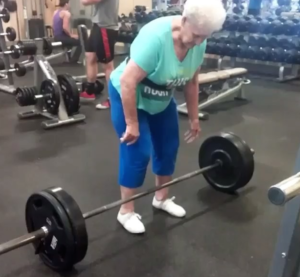
Shirley Webb, 78, from Illinois, can deadlift 225 lbs. for three reps, as of 2016.
If you’re elderly (65-plus), you should do deadlifts.
Deadlifting is a compound (multi-joint) strength training exercise.
When I was a personal trainer, I had my elderly clients doing deadlifts.
But at various gyms I’ve been at, I’ve never seen elderly men or women, other than my clients, performing barbell deadlifts.
This isn’t because they can’t. It’s because the aging population (and so many personal trainers, even) has no idea how valuable the deadlift is to the older body.
“Deadlifts, when done correctly, are beneficial for older adults,” says Monica Charlton, a senior exercise specialist and certified Silver Sneakers/personal trainer out of New Orleans.
“I have my clients do three rounds of eight deadlifts in my weekly Low Impact Class,” continues Charlton.
“We even do single-leg deadlifts if the participant wants a harder option. Obviously, the participant should have clearance from a doctor if they have back issues like bulging or herniated discs and scoliosis.”
So Why Aren’t Elderly People Deadlifting?
Some may think it’s dangerous because it’s a sport associated with huge men bending the bar as they lift.
Another reason why an elderly person will shy away from deadlifts is because he or she might think it’s too difficult to learn.
I have a surprise for you: Every woman who has ever picked up a laundry basket has done a deadlift.
The action of leaning over to pick up a laundry basket or box of Christmas decorations is similar to a deadlift.
The irony is that an elderly person is more likely to get injured (low back) stooping over with incorrect form to pick a pair of shoes or space heater off the floor, than while performing a barbell deadlift with proper form!
Research from the University of Michigan Health System highly recommends compound (multi-joint) strength training for the elderly.
“No matter what age an individual is, they can experience significant strength improvement with progressive resistance exercise even into the eighth and ninth decades of life,” says Mark Peterson, PhD, in the research paper.
Why the Elderly Should Do Barbell Deadlifts
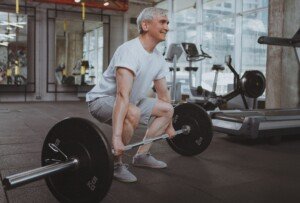
Shutterstock/ Ihor Bulyhin
Charlton explains, “Deadlifts are a great exercise because when done properly they work your quads, glutes, hamstrings, lats, traps and delts, just to name a few muscle groups.” It also works the lower back, abdomen and arms.
The elderly should perform deadlifts because this motion has applications in everyday living, such as in bending over to pick things up, including grandchildren, pets, your bowling ball in the back of the closet, etc.
How Can Elderly People Learn to Do the Deadlift?
“When doing deadlifts, you want to make sure to keep your spine neutral,” says Charlton.
“Otherwise, the weight will put a lot of pressure on your spinal discs causing injury.”
- Never let your back become rounded.
- Shoulders should always be higher than the hips.
Don’t let this advisement scare you away. By incorporating deadlifts into your exercise regimen, you will MUCH LESS LIKELY suffer injuries from the tasks of daily living including gardening, yardwork, shoveling snow, housework, and picking a potted plant or toddler off the floor.
Elderly people can learn to master the form. All you have to do is practice the movement at home … using only your own body weight against gravity. And then you can progress from there.
“But the guy in the picture looks like he’s been deadlifting for years!”
You need not lift as much weight as a Senior Games competitor to reap the rewards.
“For seniors who have been lifting [in general] for many years, doing a deadlift with a spotter, and starting with a lower weight depending on the health of your body, can be beneficial,” says Charlton.
Elderly men and women can practice the deadlift without holding any weights, or by holding a broom stick or even the laundry basket.
What about senior age people who’ve never strength trained at all and do very little exercise at all?
Charlton explains, “For those just starting to strength train, deadlifts are not an ideal exercise to begin with.
“Instead, a beginner should focus on squats [body-weight or with dumbbells] and lat pull-downs because they’re a lot easier on the body when it comes to mastering the correct form.
“Seniors should always talk with a personal trainer before they attempt any strength training to get help on the proper form so they end up reaping the benefits of training, not causing severe injuries.”
Novices should faithfully stick to strength training to eventually begin doing the deadlift. Many gyms provide five- and 10-pound bars for beginners.
The Great Mimicker
The deadlift mimics what you do in real life. As an elderly person becomes stronger from deadlifting, they will notice a big improvement in many everyday actions:
- Getting in and out of cars and deep chairs
- Lifting grocery bags out of the trunk and setting them on countertops
- Even walking up stairs.
The instructions for safely performing a deadlift apply to the elderly as much as they apply to any novice of any age.

